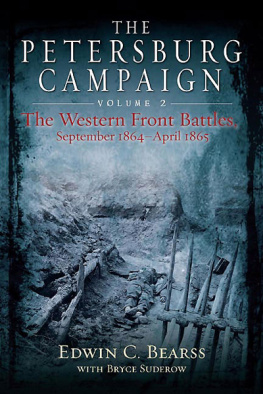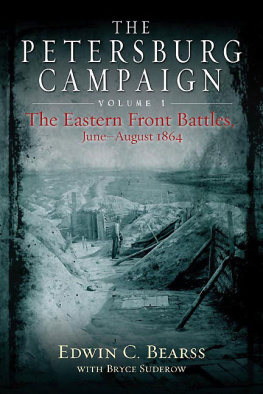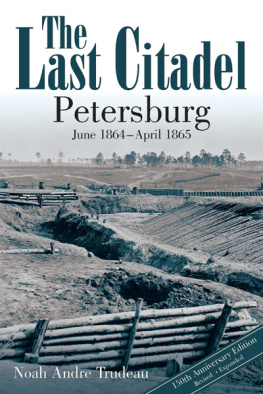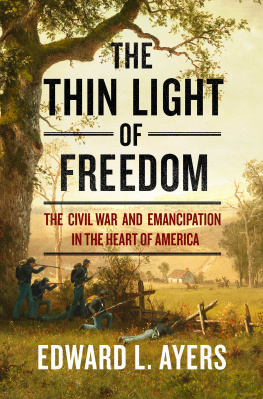
2014 by Edwin C. Bearss and Bryce Suderow
All rights reserved. No part of this publication may be reproduced, stored in a retrieval
system, or transmitted, in any form or by any means, electronic, mechanical,
photocopying, recording, or otherwise, without the prior written permission of the
publisher.
Library of Congress Cataloging-in-Publication Data
Bearss, Edwin C.
The Petersburg Campaign / Edwin C. Bearss, with Bryce Suderow.
p. cm.
Includes bibliographical references and index.
The Attack on Petersburg, June 9, 1864 The Second Assault on Petersburg, June
15-18, 1864 The Battle of the Jerusalem Plank Road, June 21-24, 1864 The
Crater, July 30, 1864 The Battle of the Weldon Railroad, August 18-21, 1864
The Second Battle of Reams Station, August 25, 1864Vol. 1, table of contents.
ISBN: 978-1-61121-104-7
EPUB ISBN: 978-1-61121-105-4
1. VirginiaHistoryCivil War, 1861-1865Campaigns. 2. Petersburg (Va.)
HistorySiege, 1864-1865. I. Suderow, Bryce A. II. Title.
E476.59.B43 2012
975.503dc23
2012028512

Published by
Savas Beatie LLC
989 Governor Drive, Suite 102
El Dorado Hills, CA 95762
Phone: 916-941-6896
(E-mail)
05 04 03 02 01 5 4 3 2 1
First edition, first printing
Unless otherwise indicated, all photographs are from the Library of Congress.
Savas Beatie titles are available at special discounts for bulk purchases in the United
States by corporations, institutions, and other organizations. For more details, please
contact Special Sales, P.O. Box 4527, El Dorado Hills, CA 95762, or you may e-mail
us at for
additional information.
Proudly published, printed, and warehoused in the United States of America.
To Mary Virginia Bearss

Inside Fort Stedman, Petersburg, Virginia, April 2, 1865
Library of Congress
List of Maps
Peebles Farm, Wilcoxs and Hamptons Attack
Phase One: September 30, 1864
Peebles Farm, The Confederate Attack
Phase Two: September 30, 1864
Peebles Farm, Heths and Hamptons Attack
October 1, 1864
Burgess Mill: Mahones Attack
October 27, 1864
Burgess Mill: Federal Counterattack
October 27, 1864
Hatchers Run
February 5, 1865
Hatchers Run
February 6, 1865
Hatchers Run
February 7, 1865
Fort Stedman: Confederate Attack
March 25, 1865
Fort Stedman: Union Counterattack
March 25, 1865
The Western Front
March 25, 1865
Battle of Lewis Farm
March 29, 1865
Dinwiddie Court House
March 31, 1865, 2:00 p.m.
Dinwiddie Court House
March 31, 1865, 2:30 p.m.
Dinwiddie Court House
March 31, 1865, 4:00-5:30 p.m.
Dinwiddie Court House
March 31, 1865, 5:30 p.m.
Battle of White Oak Road
March 31, 1865
Five Forks
April 1, 1865, 4:00 p.m.
Five Forks
April 1, 1865, 4:15 p.m.
Five Forks
April 1, 1865, 4:30 p.m.
Five Forks
April 1, 1865, 5:00 p.m.
Five Forks
April 1, 1865, 5:30 p.m.
Five Forks
April 1, 1865, 6:00 p.m.
Breakthrough
April 2, 1865
Retreat to Appomattox
April 2-9, 1865
Photos and illustrations have been placed throughout the book
for the convenience of the reader.
Introduction by Edwin C. Bearss
At the request of Theodore P. Savas of Savas Beatie publishers, I have prepared an Introduction for Volume 2 of The Petersburg Campaign: The Western Front Battles, September 1864-April 1865. The first volume of this publication, as readers recall, was subtitled The Eastern Front Battles, June August, 1864 (2012).
To avoid being too repetitive, I have revisited the subtitle to reflect a step back to provide insights into the history of how the U.S. Government and the National Park Service came to be involved in the management, preservation, and interpretation of many of the nations Civil War battlefields.
On August 17, 1890, Congress authorized the Chickamauga and Chattanooga National Military Park, Americas first. Three more national military parks followed by the end of the nineteenth century: Shiloh in 1894, Gettysburg in 1895, and Vicksburg in 1899. The War Department purchased and managed their lands while participating states, military units, and associations positioned monuments at appropriate locations. At Antietam on August 30, 1890, Congress provided for acquisition of token lands where monuments and markers could be placed. It and other places where this less expensive policy was adopted were later designated national battlefield sites. In subsequent years Antietam and most of the latter sites bearing this designation would be enlarged and re-designated national battlefields.
Congress, in 1907 authorized Chalmette National Monument and Grounds commemorating the War of 1812s Battle of New Orleans, departing from its recent focus on the Civil War. This was followed on March 2, 1917, with our first Revolutionary War site with the authorization of Guilford Courthouse National Military Park. Four weeks before in early February, Congress had authorized another Civil War site at Kennesaw Mountain, Georgia.
In 1926, Congress called upon the War Department to survey all the nationals historic battlefields and provide recommendations for their preservation or commemoration. This led Congress to add more areas to the battle sites before the August 11, 1933, reorganization that transferred the management of the nations military history sites to the National Park Service, a bureau in the Department of the Interior, which was then headed by the power-hungry and formidable Harold Ickes.
Civil War sites not heretofore listed (and their date of authorization) are as follows: Petersburg NMP, July 3, 1926; Fredericksburg and Spotsylvania County Battlefields NMP, February 14, 1927; Stones River NMP, March 3, 1927; Fort Donelson NMP, March 26, 1928; Brices Cross Roads NBS and Tupelo NBS, February 21, 1929; and Appomattox Court House NBS, June 18, 1930. Some six years later Congress authorized the Richmond NBP.
Although Petersburg National Battlefield and Richmond National Battlefield Park are separate units within the National Park system, each has its own staff and the degree of cooperation is dependent upon the personalities of the respective incumbents. The focus of the staff of Richmond NBP is on the interpretation of Richmond as capital of the Confederacy, the Seven Days Battles and Drewrys Bluff; the 1864 Overland Campaign from the Union crossing of the Pamunkey River through Grants crossing of the James River; and, sites such as Battery Parkers and Fort Stevens associated with much of Bermuda Hundred. The staff of Petersburg NMP is given priority interpreting and protecting Grants City Point headquarters; the Petersburg home front; the Five Forks battlefield; and the Western Front Visitor Contact Station and the Eastern Front Visitor Center.
* * *
Lt. Gen. Ulysses S. Grant, in the days following his June 3 bloody repulse at Cold Harbor, determined to give Gen. Robert E. Lee the slip, cross south over the James River, and attack Petersburg from the east. This would enable Maj. Gen. George G. Meade to cooperate with Maj. Gen. Benjamin F. Butlers Army of the James that had occupied Bermuda Hundred and either capture Petersburg by coup de main or, if that failed, sever the railroads connecting the Cockade City with Richmond and the Deep South. Although Grant stole a march on Lee, the heavily outnumbered Confederates under Gen. P. G. T. Beauregard, in the four days comprising June 15-18, stood tall until Lee and the Army of Northern Virginia arrived about noon on the 18th. Their arrival and Union failure to take the city as hoped led to a long and bloody investment of Petersburg and Richmond that would not end until the night of April 2, 1865. Taking advantage of Maj. Gen. Philip Sheridans Five Forks victory on April 1, the Union Sixth Corps scored a breakthrough at dawn on April 2 of the Rebel breastworks located on land preserved and interpreted in Pamplin Historical Park. This compelled the Confederates to evacuate their extensive lines and thus both cities that night. Lees and Grants date with destiny at Appomattox Court House was one week in the future.
Next page










